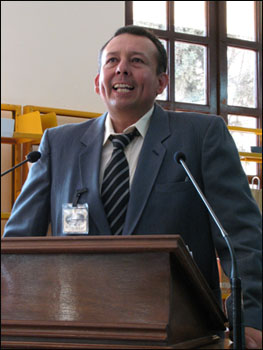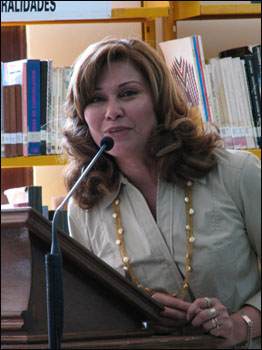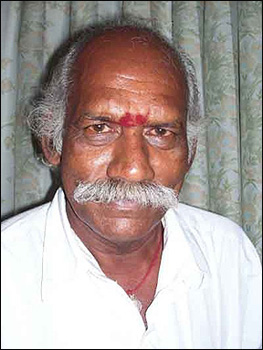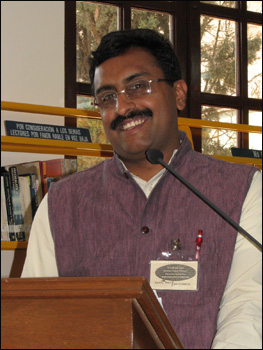By Gene D. Matlock
On April 25, 26, 27, and 28, 2007, I was invited to be a keynote speaker in Saltillo, Coahuila, Mexico, at a symposium entitled,
Globalization and the Resistance Cultures of the World. It was hosted by such distinguished Mexican personages as Professor Horacio Argani of the Latin American Branch of the Friends of Vedic Culture organization and Mrs. Norma Zapata, director of the Coahuila State Central Library. Saltillo is called the Mexican Athens. The symposium was given wide newspaper, radio, and TV publicity in Saltillo.



Left: Professor Horacio Arganis. (Courtesy of Vrndavan Parker)
Right: Mrs. Norma Zapata (Courtesy of Vrndavan. Parker)
 The title of my presentation was, The Hindu-Turkic Origin of the Ancient Mexicans. For decades I have been shouting to the housetops that the ancient Turks and Hindus had peopled both Americas. I even declared in my book, What Strange Mystery Unites the Turkish Nations, India, Catholicism and Mexico?, of which I'm immodestly proud, that when the Turkish nations, India, and the Mexicans recognize their millenniums-old kinship, a new era of peace and harmony will come to the world. If anyone thinks that politics are going to save us from the world holocaust looming before us, he is a dreamer. Only a power above us all can save us from what we seem determined to do against ourselves. A well-known Tamil Nadu holy man, Mr. T. L. Subash Chandira Bose [Right] predicted that I would someday get the results of my investigations accepted, but I would have to face tremendous opposition at first. He certainly predicted correctly.
The title of my presentation was, The Hindu-Turkic Origin of the Ancient Mexicans. For decades I have been shouting to the housetops that the ancient Turks and Hindus had peopled both Americas. I even declared in my book, What Strange Mystery Unites the Turkish Nations, India, Catholicism and Mexico?, of which I'm immodestly proud, that when the Turkish nations, India, and the Mexicans recognize their millenniums-old kinship, a new era of peace and harmony will come to the world. If anyone thinks that politics are going to save us from the world holocaust looming before us, he is a dreamer. Only a power above us all can save us from what we seem determined to do against ourselves. A well-known Tamil Nadu holy man, Mr. T. L. Subash Chandira Bose [Right] predicted that I would someday get the results of my investigations accepted, but I would have to face tremendous opposition at first. He certainly predicted correctly.
 Another principal speaker at the meeting was India's ambassador to Mexico, Mr. Ram Madhav Harandazi [Left]. He said that now that the Mexicans and the Hindus have recognized the truth of their ancient kinship, India fully intends to work closely with the Mexicans in establishing tight economic, social, and cultural relations between the two countries, both countries working for the good of both, as if they were man and wife.
Another principal speaker at the meeting was India's ambassador to Mexico, Mr. Ram Madhav Harandazi [Left]. He said that now that the Mexicans and the Hindus have recognized the truth of their ancient kinship, India fully intends to work closely with the Mexicans in establishing tight economic, social, and cultural relations between the two countries, both countries working for the good of both, as if they were man and wife.
For me, it was the most important moment of my life, for I had endured much resistance to my views on this subject for several decades. At last, I felt vindicated. For me, it was a surprise that no one had ever discovered this before. The eagle with a snake held in its beak, as seen on Mexico's flag, also exists in India, symbolizing that country's colonization of Patala (America), in about 3,000 BC, or whatever year they first conquered the Americas.
Now that I have at least been vindicated by those two countries, what more information and mysteries need to be brought to the light of day? Actually, I have just touched the surface. I can write an encyclopedic size book of evidence.
One mystery I'll attempt to clear up in this article is the location of the ancient sunken Hindu island kingdom in the Caribbean, Trikuta, which India's god of gold and good fortune, Kubera and his Yakhu, Yahu-deva, or Yaksha subjects built for themselves.
Actually, Kubera was our biblical Heber (Genesis 10:24-25) and his warriors, called in Sanskrit, Yuddhis. In ancient India, Kubera was also named Loka-palaka (protector of the world). In our Bible, Peleg was the son of Heber. In the Hindu version, Yakshas, Yakshan, Yakhu or Yahudevas were Kubera's subjects. However, in the Bible, Joktan was Peleg's little brother. Notice the linguistic similarities of these words: Kubera = Heber. Peleg = Loka-Palaka. Yakshan = Joktan.
According to the Bible, Peleg, son of Heber, scattered the races of mankind all over the world after the Great Flood. (Genesis 10:24-25.) In the Hindu version, Kubera, also Loka-palaka, took the races of mankind living at the base of Mt. Meru or Trikuta, and scattered them over the face of the earth. In ancient Mexico, Yucatan was named after Joktan.
I want my readers to know that I'm not a Mormon. I am just pointing out the similarities between our biblical stories and those in the Hindu holy books.
--NEXT--Comments? || Viewzone || Archive of Gene's Articles

